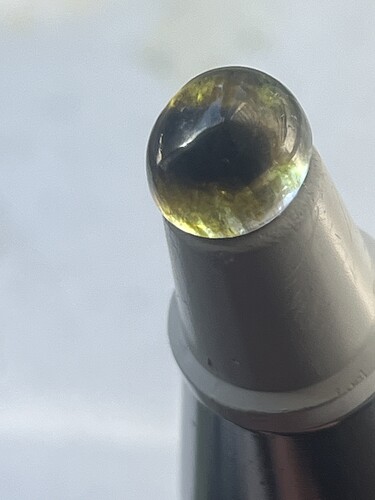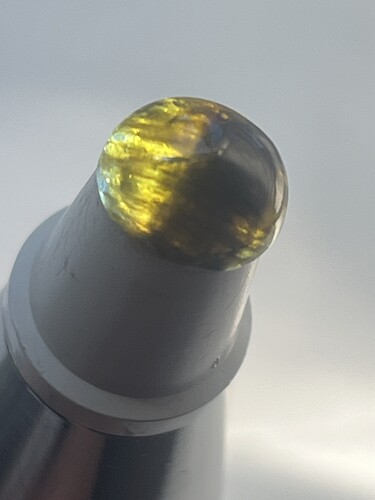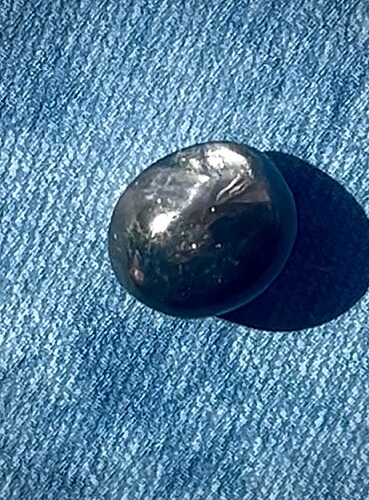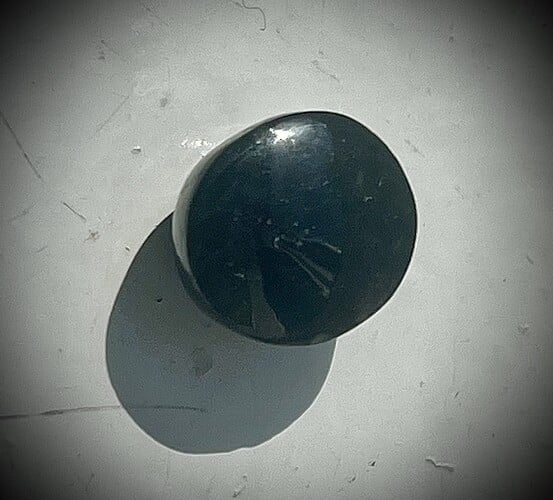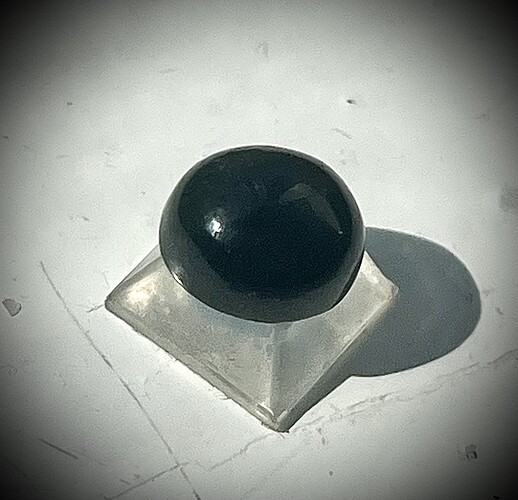This is one of those stones that is just really hard to photograph, so please forgive the variations in images, the stone changes a lot with perspective and light.
This is a natural ??? (here’s where I need help). I know it is natural for a few reasons (source, provenance, etc), so I can say with certainty it’s not synthetic, but I’m not sure what it is. It has no flat surfaces, all edges are rounded such that I can’t get an RI reading, but it’s SG is easily measured and it’s about 4 (total weight 10ct, displaces 2.5ct). It’s super hard, even without a sharp edge it easily scratches glass, and although I don’t want to take a ruby to it, I am quite sure it’s hardness is over Mohs 7-7.5, it may be closer to 8 or higher, just given how easily it left a sliver of a deep cut in glass. The stone looks black (to my eyes) in most light, it takes a lot of light or changes in photo settings to bring out its actual color, which is a sort of forest green (see pic with light). If ala exhibits am interesting chatoyance, the effect is confined to one side, and is quite pronounced when the light hits it the right way, it has the sort of silver silky colored chatoyance like some rubies. I don’t know where it was first mined/found, but to save you all me rambling about its unique history, suffice it to say it’s been around the block, so to speak, it’s centuries old (ie, it’s been that long since it was last worked), yet it’s hard enough to have survived that long with virtually no surface blemishes (none really visible).
I’m guessing it’s a type of sapphire,
but I’m anxious to get opinions. Any suggestions would be much appreciated!
1 Like
From the pictures it exhibits a exhibits a chatoyancy (cat’s eye effect) with a golden-yellow to dark color, which suggests it belongs to the cat’s eye gemstone family. Based on the hardness I am guessing a Tiger’s Eye (Quartz Variety) – More common, with golden-brown hues and a fibrous internal structure that gives it a shimmering effect.
1 Like
Hello Katherinee and Welcome to the Forum.
Obviously, Identifying any mineral is difficult when there are only photos to go by so at best, people can guess … unless there are Obvious Visible Characteristics. It could be a type of Tiger-Eye but it might even be a low-grade Chrysoberyl as well. Knowing the Specific Gravity and Actual Hardness would be very helpful in at least eliminating possibilities. Otherwise the only sure way to know would be to take it to a Gemologist (or if you prefer, Gemmologist).
Thanks! I appreciate the comments. I don’t think, however, it’s in the quartz family, just because of the chatoyance, SG, and hardness, but it could indeed be chrysoberyl or something similar. Anyhow, I like it, probably not anyone’s idea of an ideal engagement ring, but it has its own sort of natural beauty.
You could try the ‘distant vision’ approach with your refractometer; this gives a less precise reading, but at least gets you in the ballpark.
You use an even tinier amount of contact fluid than usual and you look at the reading from around 30 cms away. Move your head forwards and backwards until you see a small blob of shadow moving up and down the scale. Once you’ve located it, move back and forth more slowly to see where the shadow blob starts to disappear. Take the reading where it’s half gone.
If you can do this looking through a pinhole, you’ll find the reading shows more clearly.
1 Like
Agreed. Sapphire. SG is 4. I have seen many low grade yellow sapphires like this from the Bang Kha Cha sapphire mining area, Chanthaburi Province, Thailand
2 Likes
Thanks, I think you are right. although I don’t know much about stones from that region, given where I got it, that seems like a probably source, it lines up, as many stones from that region are traded there.
Low grade or not (I didn’t pay much for it, I bought it because I liked it), it’s sort of special to me in many ways. I love the color and the hint of chatoyance, and in bright sunlight it really comes alive, so I’d say low grade, high value (to me, lol).
